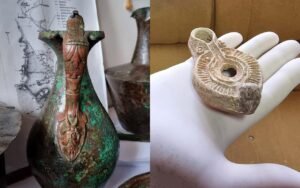Researchers exploring the historical-archaeological reserve of Marcianopolis near Devnya, Bulgaria, have uncovered a trove of artifacts dating back to the Roman era.

The director of the Museum of Mosaics, Ivan Sutev, told BTA that during the summer excavations, approximately 800 artifacts were unearthed. Among the notable discoveries are exquisite floor mosaics adorned with early Christian designs.
These intricate mosaics were found within the remains of a building, prompting archaeologists to speculate on its function, debating whether it served a public or private purpose. Ivan Sutev expressed uncertainty about whether the structure belonged to a wealthy Roman citizen or had a more communal role in Marcianopolis.
Excavations also revealed pottery fragments that have now been meticulously restored. Notable pieces include a crater-shaped pot for liquids and a mortarium vessel, both found within the same building as the floor mosaics.
In a meticulous restoration effort during the previous archaeological season, bronze vessels dating back to the late 2nd to early 3rd century were revived from a brick-walled tomb.
Sutev explained that these vessels, displaying exquisite craftsmanship, were ritually significant and linked to the identity of the deceased individual. The collection includes a vessel for pouring liquids as an offering to a deity, a wine jug with a trefoil mouth (oenochoe), and a humble kitchen pan.
A distinctive feature of this archaeological find is the presence of smaller objects alongside the vessels, including components from a folding magistrate’s chair shaped like lion and bear heads. These intricately crafted items, cast in stone molds, will be showcased alongside the bronze vessels.
Further excavation efforts in 2023 unearthed pottery around the basilica, now meticulously restored. Among the pottery finds are a crater-shaped pot for liquids and a mortarium vessel for liquids, both situated in the building with the floor mosaics.
The historical significance of Marcianopolis is further emphasized by the discovery of 20 gold coins dating back to 447. This event corresponds with the capture and destruction of Marcianopolis by Attila’s Huns, who swept through the Balkan Peninsula but failed to conquer Constantinople. The coins feature images of Theodosius II and the patron goddess of Constantinople, offering a tangible connection to the city’s tumultuous past.

Marcianopolis, initially established around 106 CE and named after Trajan’s sister, Ulpia Marciana, served as the capital of the province of Moesia Inferior. Its strategic location and importance peaked during the reign of Emperor Valens from 366 to 369, where it briefly functioned as the Eastern Empire’s temporary capital alongside part of the Constantinople Senate.






































